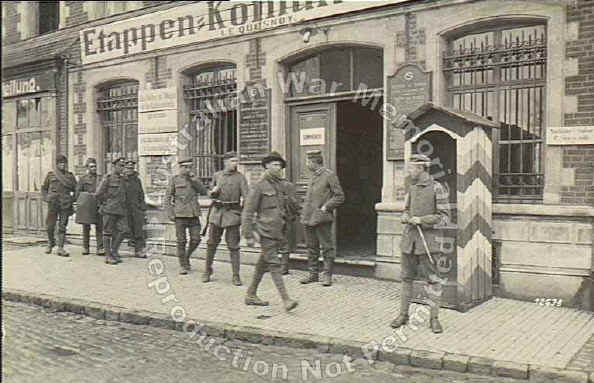|
On
the 4th November 1918, Le
Quesnoy was a little town with 5000 French people
still living there. Sited at 15 Kms south east of Valenciennes ,
west of the Momrmal Forest and less than 25 Kms from the Belgian border
and the famous town of Mons.
 |
| Le Quesnoy,
France. September 1918. German Army soldiers outside the
Headquarters of the German Army Commandant. |
The
Germans had turned the town into
a fortress using the Vauban ( Vauban was the military architect of Louis
the XIV) style fortifications of moats and 60 feet high ramparts.
Trenches, machine gun posts, artillery field guns and mortar positions
were installed all around
the walls and along the top of the ramparts.
The
New Zealand Division was given the task to take the town. In the process
to limit civilian casualties it was planned to keep the Germans on the
ramparts busy with light weapons fire and to surround the town from
North and South then to meet on the eastern side, and so to force the
enemy to surrender.
On
the 5th November 1918, the attack was launched. It was not easy fighting
. Many German machine gunners fought till the end, many sniper nests had
to be mopped up. But the assault advanced well according the plan. By
mid day both flank movements were able to meet at Herbignies village,
sited just 1 mile east from Le Quesnoy. About 500 Germans had
been taken prisoners but the German defenders in Le Quesnoy did not want
to give up.
So
it became obvious that the small town had to be assaulted. Recce patrols
gave information that the German positions were cleverly organised
nearby the moat and causeways of outer positions. Ramparts were also
high.
Fortunately
and after several attempts , the Kiwis got nearer the outer ramparts.
2nd Lieut Francis Evans 4th NZRB leading a strong patrol took a German
machine gun position near the outer moat. Some of the Germans were seen
running to the moat and calling his men .
Under
the cover of the maze of moat , mist and smoke the Kiwi officer followed
the enemies and reached the foot of the outer ramparts where Germans
were unable to shoot him. But the smoke
started to clear . Evans and his men became easy targets. Evans
was killed… and the survivors simply pinned down by enemy
fire and hand grenades.
In
the way to spare lives, the New Zealanders
sent German prisoners in the city
with message to propose the surrender . Germans refused again. Le
Quesnoy was still a hard nut to crack.
The
4th NZ Rifle Brigade commanding
officer , Lieut Col Barrowclough decided to launch a new assault .
German inner defences became the target of British artillery fire and
smoke barrage. With great bravery and determination the Kiwis went over
the top and reached the
high inner walls .Then here
was a blocked up bridge
across the moat from which with scaling
ladders the top could be reached. With 2 or 3 ladders the Kiwis climbed
up the ramparts and swarmed up. Barrowclough was among the assaulters.
Most of the German soldiers surrendered.
Officially
the first New Zealanders to enter the Town were
Lt H.C. KERR and 2nd Lt A.C. Averill . Casualties were over 200
for the Kiwis and about 250 Germans had been killed.. 700 others Germans
had been taken prisoners ( some documents are saying 1000) and
5 artillery field guns, 11 trench mortars, 45 machine guns as
well.
Today
in Le Quesnoy there are two streets bearing the names of New Zealand. On
the ramparts beside the site of the assault the NZ memorial depicts
soldiers climbing these walls just 7 days before the Armistice was
signed.
Lt
Francis Evans is today Resting in Peace with many of those who died at
Le Quesnoy at Romeries British cemetery.
Yves
Fohlen 26 June 2003
|